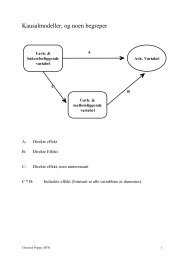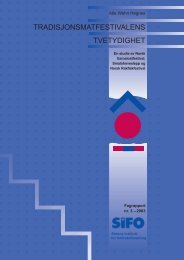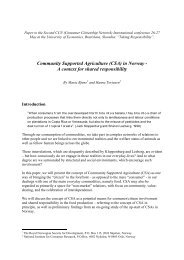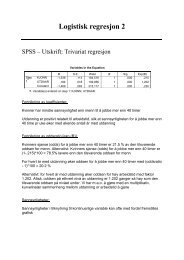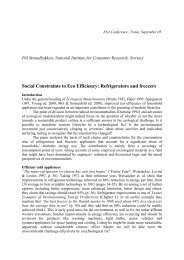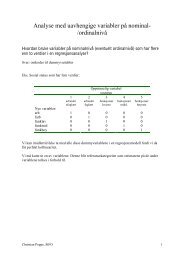Dimensions of Taste for Cultural Consumptionâ An Exemplar ... - SIFO
Dimensions of Taste for Cultural Consumptionâ An Exemplar ... - SIFO
Dimensions of Taste for Cultural Consumptionâ An Exemplar ... - SIFO
You also want an ePaper? Increase the reach of your titles
YUMPU automatically turns print PDFs into web optimized ePapers that Google loves.
Taru Virtanen, M. Sc. (Econ. & Bus. Adm.)Researcher, PhD CandidateEconomic Sociology/ Turk School <strong>of</strong> Economics and Business AdministrationRehtorinpellonkatu 3, FIN-20500, Finland, taru.virtanen@tukkk.fi; tel. + 358-41-440 7876<strong>Dimensions</strong> <strong>of</strong> <strong>Taste</strong> <strong>for</strong> <strong>Cultural</strong> Consumption– <strong>An</strong> <strong>Exemplar</strong> <strong>of</strong> Constructing a<strong>Taste</strong> PatternThe 7th ESA Conference, September 2005, Research Network “Sociology <strong>of</strong> Consumption”AbstractAccording to Van Eijck (2000) today’s cultural consumption is mostly determined by the breadth <strong>of</strong> activitiesparticipated rather than just based on the quality <strong>of</strong> most participated items. It seems, according to some preliminary andalso more thorough empirical studies, that there has been a change, which might also be taking place currently, in the ways<strong>of</strong> which traditional high cultural elements have lost their explanation power, in which case the consumption <strong>of</strong> culturalproducts must be interpreted also from the point <strong>of</strong> view <strong>of</strong> the combination <strong>of</strong> all consumption. These combinations <strong>for</strong>m aset <strong>of</strong> patterns or consumer types, sometimes referred <strong>for</strong> example as omnivorous, univorous or voracious.Here, cultural consumption patterns are shed light on. The primary interest in this paper is to <strong>for</strong>m an applicablemeasurement <strong>for</strong> pattern in order to determine the consumption <strong>of</strong> cultural products. The universe in which the research iscarried out comprises <strong>of</strong> the young European adults (20–35 years) residing in the European Union (as in the year 2001).As indicators <strong>of</strong> potential social distinction, consumption items in <strong>for</strong>ming the patterns such as cultural activities, musicaland preferences and artistic hobbies are used. The article scrutinizes the structure <strong>of</strong> taste and its relation to culturalconsumption patterns.1
in its <strong>for</strong>ms. These issues are important to keep in mind, even though the scope in this article is not toscrutinize the reasons and conditions shaping the cultural consumption. There seems to be few issuesthat keep surfacing when explaining the consumption patterns regardless <strong>of</strong> the period <strong>of</strong> time or theangle <strong>of</strong> approach. One <strong>of</strong> these issues is the role <strong>of</strong> social class. Studies concerning culturalconsumption <strong>of</strong>ten reflect on social inequality or social stratification, and they mainly focus onconsumption <strong>of</strong> highbrow culture. Typically the findings show that the higher educated people attendmore on the items in the field <strong>of</strong> highbrow culture such as literary reading, museum visits, ballets,operas and theatre (Van Eijck 2000, 208).Katz-Gerro and Shavit (1998) claim, that in post-industrial societies no single important factordetermines one’s cultural tastes. Whereas position in the labour market has seized to be the topmostdefiner <strong>of</strong> an individual, more stress has been laid on such characteristics as ethnicity, religion andgender. We can further argue that educational credential seem to play an important role in cultivatingtaste <strong>for</strong> cultural orientation. As social class, education and income all are both intertwined and veryimportant in the process <strong>of</strong> producing the taste <strong>for</strong> cultural consumption, we can see why there hasbeen several, sometimes differing explanations <strong>for</strong> this practice.Post-modern reasoning stresses other alternative determinants <strong>of</strong> cultural consumption patterns thanthe traditional approach <strong>of</strong> ‘class and culture consumption’, which has been criticized <strong>for</strong> oversimplification(Bihagen – Katz-Gerro 2000, 329). These options include complementary factors such asage, gender, ethnicity, and religious orientations to mention a few (cf. Toivonen 1992; 1996; Katz-Gerro – Shavit 1998; Wilska 1999; Räsänen 2003). Solid evidence have been found in several studiesacross the western world that those who are well educated and have high status jobs are in fact moreinclined to omnivorous patterns <strong>of</strong> consumption (Peterson 2004). Similar circumstances seem toinfluence on the omnivorous and voracious consumption. Both are equally tied up with educationalqualifications, occupational status, age and gender, according to Sullivan and Katz-Gerro (2004).In Katz-Gerro’s (2002) cross-cultural study, it seems that same variables affect the consumption <strong>of</strong>highbrow lifestyle in the same direction in all the countries, regardless <strong>of</strong> the social and otherdisparities. Older persons, the more educated, women, the more affluent, and urban residents tend tobe leaning more towards the highbrow. There are some disruptions in the pattern in the case <strong>of</strong> someparticular youngsters, which also makes age an important factor worth considering. The maindeterminant <strong>for</strong> highbrow cultural consumption is education along with classes fluctuating impactbetween countries.Individualisation argument stands as an opposite <strong>for</strong> the traditional homology argument being aproduct <strong>of</strong> postmodernist frame <strong>of</strong> mind. The argument is briefly that, cultural taste and consumptionhave lost their grounding in social hierarchies; consumption cannot be explained by issues related toone’s status. (Chan – Goldthorpe 2005). The more strict stream suggest that structures <strong>of</strong> any kind cannot be predicted to shape consumption, whereas the weaker versions suggest that other structural baseshas come to replace class in explanation <strong>of</strong> consumption. For example Erickson (1996, 218–219) hasargued with her empirical support, that in the case <strong>of</strong> advantaged people (<strong>for</strong> example in high labourmarket positions or with high income or features related to omnivorousness) there is no one kind <strong>of</strong>taste pr<strong>of</strong>ile that they share.<strong>Cultural</strong> competency is generally thought to be reproduced both within families and <strong>for</strong>mal educationsystems, and inequality is a by-product <strong>of</strong> this development (see e.g. Kesler 2003, 469). <strong>Cultural</strong>competence is closely related to distinctive consumption, <strong>of</strong> which Bourdieu’s (1984) analysis isundoubtedly most renowned. Distinction becomes visible in the processes <strong>of</strong> all kinds <strong>of</strong> consumptionwhere symbolical power is used in order to achieve or maintain one’s status. <strong>Cultural</strong> competence isthus a part <strong>of</strong> the mechanism where also cultural capital is included. <strong>Cultural</strong> capital is one <strong>of</strong> the threeresources used in status struggle, according to Bourdieu (Holt 1998). Although all these resources are4
eing implemented in every aspect <strong>of</strong> life, in the field <strong>of</strong> consumption, which is relevant in the light <strong>of</strong>this study, cultural capital operates in <strong>for</strong>m <strong>of</strong> tastes. Those tastes become visible in consumptionpractices (ibid., 4).According to Erickson (1996, 219) “the most widely useful <strong>for</strong>m <strong>of</strong> cultural resource is cultural varietyplus the (equally cultural) understanding <strong>of</strong> the rules <strong>of</strong> relevance.” This means that a wide spectrum <strong>of</strong>knowledge on all sorts <strong>of</strong> cultural phenomena gives an individual a possibility to adopt this knowledgeto his favour in changing social situations. This will naturally give the most advantage thus it proves tobe useful to have both wide range <strong>of</strong> interest and an understanding on the ways <strong>of</strong> conduct (i.e. rules)in differing situations. She continues with a statement on the limited importance <strong>of</strong> cultural capital. Forsome time a person well-stocked on cultural resources is under positive influence <strong>of</strong> this quality. Forexample some choices related with marriage or education are directed by cultural capital. (ibid., 221.)The logic <strong>of</strong> high culture and popular culture boils eventually down to taste. Even though the logic <strong>of</strong>some object to be asserted the qualities <strong>of</strong> high culture is to say at least complex and illogical we canfind a phenomenon that helps to disentangle and interpret the ways <strong>of</strong> high, low and popular. Thisphenomenon is fashion, a mechanism that has been thoroughly studied by many scholars both in thefield <strong>of</strong> sociology and other disciplines. One <strong>of</strong> the most influential writings on fashion is that <strong>of</strong> GeorgSimmel, who scrutinizes fashion and its essence in the essay “The Philosophy <strong>of</strong> the Fashion” (1986[Philosophie der Mode 1905]) the way, which is fully applicable in today’s world.One sociological explanation <strong>for</strong> cultural consumption is family socialization. Values and practices are<strong>for</strong>med within family and they are shaped in an intergenerational mechanism. This has been argued toreassert upholding <strong>of</strong> class status. Arts appreciation can be trained, say some researchers. One mustlearn to read the work <strong>of</strong> art in order to appreciate it, in the same manner as we learn to decipher alanguage. This is achieved with a lot <strong>of</strong> training, but <strong>of</strong> course it becomes less hard if one was born inright kind <strong>of</strong> supporting surroundings. Thus we might assume that the children <strong>of</strong> visually or musicallysophisticated families are greatly advantaged. Other place <strong>for</strong> training is naturally school. These bothrealms have been mentioned together with cultural capital; by definition cultural capital is created bothin family socialization and schooling. The literature and research regarding cultural consumption hasproved that in fact, education is a critical predictor <strong>of</strong> consumption <strong>of</strong> high arts but not the popularones, suggesting that education is only important <strong>for</strong> understanding the more complex codes thatprevail in highbrow arts. (DiMaggio – Useem 1978.)DiMaggio and Useem (1978) have presented a proposition on class cohesion improvement, which hasto do with social solidarity <strong>of</strong> those who attend the same type <strong>of</strong> events. This <strong>of</strong> course increases thepossibility <strong>of</strong> exclusion in the pursuit <strong>of</strong> inclusion. The members <strong>of</strong> upper-middle or upper classeswould like to maintain their position by erecting boundaries, which might by impossible by those <strong>of</strong>lower class members to surmount. Thereby ideological unity is rein<strong>for</strong>ced, and the class homogeneity<strong>of</strong> the participants ensures that social unity is also perpetuated. Also, the opportunity <strong>for</strong> the uppermiddleclass member to identify with upper class can be one reason <strong>for</strong> arts audience participation. Itcan be called status maintenance or in some cases status elevation/promotion. (DiMaggio – Useem1978.)MethodThe motivation <strong>for</strong> writing this paper is derived from the conditions which have to be met whenunveiling the essence <strong>of</strong> patterns presented by van Rees and colleagues (1999). Most <strong>of</strong> the recentstudies have failed in meeting the conditions proposed either by concentrating too much on a singlecultural sector or <strong>for</strong>m <strong>of</strong> consumption, or addressing preferences rather than actual behaviour.Moreover, the fluctuation within pattern’s content according to time and to the society in question has5
proven to be a difficult task to overcome. The motivation here is to concentrate more in defining thepattern, which has also according to López Sintas and García Alvarez (2004, 465–466) been almostnon-existent task in previous research.In this article the field <strong>of</strong> cultural consumption pattern is attempted to be characterized among thetarget group <strong>of</strong> young adults residing in the EU. Here we try to look whether the objects <strong>of</strong> culturalconsumption <strong>for</strong>m internally coherent dimensions. Several propositions <strong>for</strong> operationalization <strong>of</strong> thetaste patterns are provided. The essence and “place” <strong>of</strong> each item are tried to fit into the composition<strong>of</strong> broader consumption orientations; <strong>for</strong>ms <strong>of</strong> taste are thus addressed. Thus, research question and itssub-questions can be posed as follows:1) Can we find dimensions <strong>of</strong> cultural consumption objects?1a) What characterizes distinct cultural consumption items?1b) Do items <strong>for</strong>m dimensions <strong>of</strong> internal logic which clearly differs from others?Here an attempt on presenting one tentative pattern is made. The purpose is to enlighten a potentialway to construct cultural consumption taste pattern. The focus is on describing the method how tastepattern can be approached, and thus suitable fractions <strong>of</strong> data are used. This is why the whole <strong>of</strong> targetgroup is not studied and thus the aim is not give a holistic and detailed picture <strong>of</strong> all young Europeansin the data. The emphasis on this paper is thus not in the discussion over results but rather in thestrengths and weaknesses that the present operationalization possesses. The contribution <strong>of</strong> this paperis hoped to prove useful when applying the constructed pattern in the future studies. As a result anexemplar <strong>of</strong> potential model <strong>for</strong> pattern to be applied in future research will be presented.<strong>Cultural</strong> consumption is studied in <strong>for</strong>m <strong>of</strong> cultural activities and artistic involvement, i.e. culturalhobbies. In addition, media preferences, i.e. taste <strong>for</strong> TV programs, radio programs and types <strong>of</strong>internet use are included as potential contents <strong>of</strong> the overall patterns. Leisure reading and listening tomusic is also included; the <strong>for</strong>mer is considered in the amount <strong>of</strong> books read per year and the latterincludes both the type <strong>of</strong> music preferred and participated (a specific activity <strong>of</strong> concert-going).SampleA Eurobarometer data (Eurobarometer 56.0; Christensen 2001) on in<strong>for</strong>mation and communicationtechnologies, financial services, and cultural activities in respect <strong>of</strong> cultural consumption is used in theattempt on operationalization, and the sub-group <strong>of</strong> young adults, aged 20–35. The data set covers the15 member countries <strong>of</strong> the collection year 2001 and 4747 young consumers are included in total.The consumers and their patterns can be reflected upon their socioeconomic characteristics such aseducation, occupational status (class), income, gender, marital status and age, but here any <strong>of</strong> thebackground variables are not referred other than in the description <strong>of</strong> data presented in the appendixtable A1.Consumption items. <strong>Cultural</strong> consumption patterns can be measured with several kinds <strong>of</strong> variables.The first set <strong>of</strong> variables (“activities”) asks the respondents “Did you go to any <strong>of</strong> the following culturalactivities within the past twelve months?” Also the number <strong>of</strong> times the consumer has gone to theseactivities per year is measured and applied. The second set measures <strong>for</strong> respondents’ general tendency<strong>for</strong> cultural hobbies (“hobbies”). There are also variables referred as “supportive cultural consumptionitems” <strong>of</strong> which TV documentaries (watched) and leisure reading (yes/no in general) are referred in thispaper. Both music type (genre) preferences and actualized tastes are studied. Music taste actualized ismeasured with musical concerts participated within last 12 months. <strong>Cultural</strong> consumption can also bestudied in <strong>for</strong>m <strong>of</strong> media preferences, i.e. taste <strong>for</strong> TV programs, radio programs and types <strong>of</strong> internetuse, but since the scope <strong>of</strong> this paper is illustrative, these items are omitted in the example.6
Table 1. Proportions <strong>of</strong> the variables in the data set <strong>of</strong> young adults (n = 4747)Dimension <strong>Cultural</strong> item % Dimension <strong>Cultural</strong> item %Ballet 13.7 Classical 20.6Cinema 80.2 Opera, operetta 5.0Theatre 29.7 Rock, pop 75.8Concert 41.7 Type <strong>of</strong> music Hard rock/ heavy 18.5listenedmetalActivities Library 41.8 Easy listening 35.0Historical 46.9 Dance/house 32.0monumentsMuseum 33.0 Techno 19.5Museum abroad 21.2 Rap 1.7Archaeological 17.8 Jazz, blues 21.5sitesInstrument 16.7 Folk, traditional 20.2Singing 23.1 Classical 4.8Hobbies Acting 5.6 Type <strong>of</strong> concert Opera, operetta 1.6goneDancing 28.5 Rock, pop 27.6Writing 19.2 Hard rock/ heavy 4.4metalPhotographing 37.1 Easy listening 2.3Sculpture, 19.5 Dance/house 3.0painting, drawingetc. otherTV documentaries 61.1 Techno 1.9Supportive Read <strong>for</strong> leisure 52.3 Rap 1.4Jazz, blues 4.7Folk, traditional 4.1Source: Eurobarometer 56.0 data (Christensen 2001.)Pattern as an internally coherent logicWhen we refer to pattern, or better yet are willing to address it time and time again, we need to beaware <strong>of</strong> the limitations and expectations that are interfaced with it. In order to look up <strong>for</strong> a pattern ina data set, whatever it is called, some sort <strong>of</strong> internal logic needs to be applied in the explorationprocess, as the definition itself describes. Thus, we need, at least to some extent, disassociate ourselvesfrom the previous assumptions in the literature related to the fixed status or value <strong>of</strong> each item orconsumer.There are many possible alternative and simultaneously applicable ways to refer and measureconsumption tendencies, <strong>of</strong> which some are presented below. Applied together they can at least tosome extent add some dimensionality in consumption patterns, as they attempt to measure divergentaspects. In next chapters, I will provide some propositions, how to gain more in-depth knowledge oncultural consumption patterns. The propositions are first put <strong>for</strong>ward in the list below. In order to gaina broader view on cultural consumption patterns, we can:7
1) measure the general activity index in order to determine the active and passive consumption(countries in this context). This leads to better understanding <strong>of</strong> general tendency, regarding theintensity/breadth <strong>of</strong> which items, or eventually patterns, are consumed2) rank the consumption items in order to determine the relative value <strong>of</strong> the items. This willenable the reference to “browship” (highbrow/lowbrow) or quality <strong>of</strong> consumption items, andit also enables comparison between societies, in which status differentiation might occur.3) measure the means on the volume <strong>of</strong> activities consumed in order to determine heavy-users andothers. This leads to better understanding <strong>of</strong> intensity <strong>of</strong> consumption.4) construct multi-item presentation in order to determine the breadth <strong>of</strong> consumption, whichalso enables to isolate potential “vorousness” types.5) explore the linkage between intensity and breadth, e.g. heavy-user and multi-liking vs. light-userand multi-liking vs. heavy-user and narrow taste. This leads to a possibility to create severalpatterns with multidimensionality.Next, some the above-mentioned aspects are empirically explored. Illustrative examples are presentedusing the available Eurobarometer 56.0 data set. In the beginning <strong>of</strong> each illustration the abovementionednumbering is referred.(1) Activity in general is an aspect that relates closely in scrutinizing pattern. When makingcomparative attempts over cultural boundaries (i.e. cross-cultural) we need to take into account the factthat the overall tendency <strong>of</strong> participation and activity regarding cultural consumption varies greatlyfrom country to country. There might be several differing reasons <strong>for</strong> this fluctuation, but neverthelessaddressing activity (versus passivity, or perhaps other-orientation) is relevant. In order to solve theproblem <strong>of</strong> activity I constructed general activity index by summing up the proportions <strong>of</strong> each 15countries <strong>of</strong> every given aspect <strong>of</strong> cultural consumption.Here the activity on cultural participation is measured individually <strong>for</strong> each EU member countries, andcountries are presented in the order <strong>of</strong> their index <strong>for</strong> overall intensity in all the measured culturalactivities. When <strong>for</strong>ming the index the number <strong>of</strong> yearly participation <strong>of</strong> all the activities (9 in total) aresummed up. For example, in Denmark (first in order) attendance in the activities on yearly basis oncinema in on average almost 5 times, and going to library almost reaches up to 6 times per year. Sincesome <strong>of</strong> the activities are participated less than once a year and some considerably more <strong>of</strong>ten, theindex is able to tell <strong>of</strong> general participation rate in each country.Table 2. General activity index (1) (n= 4747)DK SWE SPA FIN NET LUX IT IRE GB FRA BE GER AUT GRE POR20,0 17,9 16,6 16,1 16,0 15,8 15,5 14,2 13,3 12,7 12,6 11,5 11,4 10,9 9,9Source: Eurobarometer 56.0 data (Christensen 2001.)(2) Relative value or the quality <strong>of</strong> items can be expressed in the <strong>for</strong>m <strong>of</strong> popularity. Here, I providewith two examples <strong>of</strong> the hierarchy that exists in the universe <strong>of</strong> cultural consumption objects. The firstone (Example x.) presents the ranking order based on the general consumption proportion(consumed or not) first among all the Europeans, then among the young Swedes (one <strong>of</strong> the mostactive ones in multiple terms). Several cultural consumption domains with differing contents andinternal logics are presented.8
Table 3. General consumption proportion among all the young adults and among the Swedes, ranked inpopularity order within the category, %<strong>Cultural</strong> activeness item All EU <strong>Cultural</strong> activeness item SwedenCinema 80,1 Cinema 90,2Historical sites 47,3 Library 74,8Library 42,3 Historical sites 69,8Concert 42,1 Concert 51,1Museums in own country 32,9 Museums in own country 48,9Theatre 29,4 Theatre 37,4Museums abroad 22,1 Museums abroad 24,9Archaeological sites 18,1 Archaeological sites 12,5Ballet 14,0 Ballet 11,8<strong>Cultural</strong> awareness item<strong>Cultural</strong> awareness itemWatching TV documentaries 62,3 Watching TV documentaries 81,0Reading books <strong>for</strong> other purpose thanReading books <strong>for</strong> other purpose than education 72,8education or work 53,4 or work<strong>Cultural</strong> hobby item<strong>Cultural</strong> hobby itemPhotographing or filming 35,4 Photographing or filming 61,0Dancing 27,9 Singing 41,3Singing 22,8 Dancing 37,0Other (sculpture, painting, drawing,Writingdesigning…) 19,435,7Writing 18,5 Other (sculpture, painting, drawing, designing…) 30,8Playing an instrument 17,1 Playing an instrument 29,5Acting 5,6 Acting 10,2Type <strong>of</strong> music listenedType <strong>of</strong> music listenedRock, pop 76,9 Rock, pop 86,2Easy listening 38,6 Easy listening 44,9Dance/house 32,8 Hard rock/ heavy metal 36,1Jazz, blues 22,2 Dance/house 31,5Folk, traditional 21,9 Classical 30,2Classical 21,5 Folk, traditional 23,9Techno 18,6 Techno 23,3Hard rock/ heavy metal 18,3 Jazz, blues 23,0Rap 16,4 Rap 18,0Opera, operetta 5,1 Opera, operetta 7,9Type <strong>of</strong> concert goneType <strong>of</strong> concert goneRock, pop 67,9 Rock, pop 77,6Classical 11,6 Hard rock/ heavy metal 16,4Jazz, blues 11,3 Jazz, blues 12,5Folk, traditional 11,3 Classical 9,2Hard rock/ heavy metal 10,4 Folk, traditional 5,9Dance/house 8,1 Rap 5,3Easy listening 6,4 Dance/house 5,3Techno 4,3 Easy listening 4,6Opera, operetta 3,8 Techno 2,6Rap 3,5 Opera, operetta 2,6Source: Eurobarometer 56.0 data (Christensen 2001.)9
As we can see in the table on general consumption proportions similar items tend to be placed either inthe most popular or least popular <strong>for</strong>ms <strong>of</strong> music genre preferred, <strong>for</strong> example both in general EU leveland single society’s level, here Sweden. As we can anticipate, popular music seems to be the mostpopular genre universally, whereas opera and operetta is in the bottom <strong>of</strong> the popularity hierarchyamong young adults. The same happens in the case <strong>of</strong> the activities, and hobbies. The order is notexactly similar between the compared categories (EU/Sweden) but the ends tend to remind each other.The practical reason why there seems to be some discrepancy between the music preference (musictype listened) and actualization (type <strong>of</strong> concert gone) lies in availability. There probably is less supplyin some areas or genres than others, plus <strong>for</strong> some music genre events the ticket prices can createboundaries, which is not that evident in the case <strong>of</strong> listening to a record at home.The second presentation (Table 4.) is based on the volume <strong>of</strong> which each individual item is consumed,and we are able to apply fewer items than in the previous, since not every consumption object here canbe measured on the basis <strong>of</strong> intensity. Thus, we are able to compare the results depending on thevarying approaches applied in measuring.Table 4. Example on relative value (based on intensity in participating) <strong>of</strong> cultural activities withinsome countriesDK SWE SPA AUT GRE PORLibrary 5,8 Library 5,6 Cinema 7,0 Cinema 4,6 Cinema 4,6 Cinema 3,8Cinema 4,3 Cinema 4,5 Library 3,0 Library 1,6 Historical 1,2 Library 1,4monumentsHistorical 3,0 Historical 2,6 Historical 1,9 Historical 1,3 Library 1,1 Historical 1,4monuments monumentsmonumentsmonumentsmonumentsConcert 2,1 Concert 1,8 Concert 1,4 Concert 1,0 Archaeological0,9 Concert 1,3sitesMuseum 1,7 Museum 1,3 Theatre 1,0 Museum 0,9 Theatre 0,8 Museum 0,8Museum 1,1 Museum 0,8 Museum 0,9 Theatre 0,9 Concert 0,8 Theatre 0,4abroadabroadTheatre 0,9 Theatre 0,8 Archaeological0,6 Ballet 0,5 Museum 0,7 Archaeo-0,4siteslogical sitesArchaeological0,7 Archaeo-0,3 Museum 0,5 Museum 0,4 Ballet 0,4 Ballet 0,3siteslogical sitesabroadabroadBallet 0,3 Ballet 0,3 Ballet 0,3 Archaeological0,3 Museum 0,3 Museum 0,2sitesabroadabroadSource: Eurobarometer 56.0 data (Christensen 2001.)(3) We can use the means <strong>for</strong> yearly attendance also as a basis in determining roughly the heavy-usersand the others. We need a point <strong>of</strong> reference <strong>for</strong> each single item in given society in order to define aline between a heavy-user and a regular-user or light-user. We can also have a category <strong>of</strong> zero-users(referred as ostravorousness in my previous writings, Virtanen 2004; 2005; see also below in section (4))in order to gain more understanding on the patterns.10
Table 5. Means and standard deviations <strong>for</strong> participation volume by cultural activity <strong>of</strong> all young adults(n = 4747)Mean Std. DeviationBallet 0,3 1,1Cinema 4,7 4,3Theatre 0,8 1,8Concert 2,5 3,9Library 1,3 2,4Historical monuments 3,0 4,7Museum 1,8 2,9Museum abroad 1,0 2,1Archaeological sites 0,6 1,7Ballet 0,5 1,3Source: Eurobarometer 56.0 data (Christensen 2001.)The standard deviations tell <strong>of</strong> the similar or differing popularity <strong>of</strong> given activity between countries. Itseems that in general going to ballet, as unpopular – or rarely attended – it is, is universally sharedfeature. Whereas on the other end <strong>of</strong> the popularity the cinema-going varies greatly from country tocountry in terms <strong>of</strong> volume <strong>of</strong> attendance. Overall, young adults go see a movie approximately 5 timesa year, where as ballet is an activity consumed less than once in a three years’ period. For example theSpaniards go to movies 7 times a year in average, as the lowest nation to engage this activity are theFinns with 2,8 yearly mean. When it comes to ballet the variation <strong>of</strong> attendance goes from 0,2(Germany and Ireland) <strong>of</strong> the least active to 0,6 <strong>of</strong> the most active ones, the Dutch.(4) <strong>Taste</strong> typologies can be constructed by summing up consumer’s breadth <strong>of</strong> consumed culturalitems. In other words, here the number <strong>of</strong> different activities participated by one consumer iscalculated and consumers can be regarded in terms <strong>of</strong> their vorousness i.e. the repertoire or multilikedness.We can anticipate four categories <strong>of</strong> ‘vorousness’ according the classical vorousness writings:univorous, omnivorous, voracious and, what I have decided to address here (and in a previous paperVirtanen 2004; 2005) as ostravorous. Ostravorousness refers to ostracism, which means that one hasaversion towards all the cultural consumption items studied here. The consumer pattern <strong>of</strong> an ostravoreis rather interesting theoretically, since it is laden with some sort <strong>of</strong> marginality. The non-consumers arestudied also previously, by <strong>for</strong> example López Sintas and García Alvarez (2002), and they do <strong>for</strong>m asociologically interesting sub-group worth wider consideration.In multi-item construction, total number <strong>of</strong> cultural activities attended and cultural hobbies possessedwere utilized. In addition, a third category <strong>for</strong> determining patterns was <strong>for</strong>med using the previouslymentioned items plus those, which are referred as ‘supportive’ above. Those, who have not taken partin a single activity during the last 12 months or do not have a cultural hobby, fell in the first category <strong>of</strong>ostravorous accordingly. 10 percent <strong>of</strong> young adults regarding activities and even 44 percent when itcomes to hobbies belong to this marginality. In case <strong>of</strong> all the cultural items the proportion <strong>of</strong> nonconsumersis about 3 percent. For other patterns, we defined measurements based on means andstandard deviations as presented in table 6 below.11
Table 6. Means and standard deviations <strong>for</strong> items, and suggestion <strong>for</strong> pattern cut-points (n= 4747)Mean Std. Deviation Univorous Omnivorous VoraciousSum activities 3,30 2,4 1–3 4–6 7–9Sum hobbies1,30 1,5 12–34–6Sum activities +hobbies + supportive 5,70 3,6 1–5Source: Eurobarometer 56.0 data (Christensen 2001.)6–910–17As we can determine the average number <strong>of</strong> different items engaged to, we can use this in helping todetermine the categories <strong>of</strong> “vorousness”, which is more scrutinized and justified than just assumptionsand “nice-looking” categories that are presented above. Thus we can decide, that the mean consumer ingiven dimension is a cutting point, whereas the one’s consuming less are defined Univorous (and in thecase <strong>of</strong> not consuming at all Ostravorous) and the ones consuming more are either omnivorous orvoracious. The latter ones can be defined with standard deviation. The omnivorous comprise <strong>of</strong> thosewho consume items an amount between mean and mean plus one standard deviation. The onesconsuming even more, in the case <strong>of</strong> activities <strong>for</strong> example more than 5,7 items (=6) are voracious.Table 7. Type <strong>of</strong> “vorousness” measured by sum variable <strong>of</strong> cultural activities, <strong>of</strong> cultural hobbies plussupportive consumption. (N = 4747)Activities %none 9.9Tentative type <strong>of</strong>“vorousness”in activitiesostravorous10 %Hobbies %none 43.6Tentative type<strong>of</strong> “vorousness”in hobbiesostravorous44 %univorous35 %Activities +hobbies +supportive%Tentative type<strong>of</strong>“vorousness”none 3.2 ostravorousone item 18.3univorousone item 20.51-3 items 29.1 univorous2 items 17.1 49 % 2 items 14.2 omnivorous 4-9 items 51.4 omnivorous3 items 13.83 items 10.8 16 % 10-17 items 16.3 voracious4 items 11.5 4 items 5.8 Total 100.0omnivorousvoracious5 items 10.2 5 items 3.529 %5 %6 items 7.6all items 1.37 items 5.9 Total 100.0voracious8 items 3.312 %all items 2.4Total 100.0Source: Eurobarometer 56.0 data (Christensen 2001.)As is visible in the above table, and what can be gathered by common knowledge and from previousliterature, different amount <strong>of</strong> items consumed by one consumer is applicable in each different culturalcontext. In other words, some cultural domains require more time devotion than others, and thus thescope becomes limited and not as many items can be included in one consumer’s repertoire as in other,less time-consuming domains. Here we can see roughly what separates <strong>for</strong> example omnivorous fromvoracious in cultural activities and cultural hobbies. What remains to be solved, is whether there aresome distinctive items that make the substantial difference, that is to say, whether consumption <strong>of</strong> agiven item is a good predictor <strong>of</strong> belonging to some particular group.12
DiscussionSeveral approaches were presented above in empirical terms. These presentation need to be elaborated,and some <strong>of</strong> their in<strong>for</strong>mation needs to be merged. The linkage between intensity and breadth(proposition 5) was not provided within the examples, and it will remain as future challenge. However,some classifications regarding general consumption activity, the relative value <strong>of</strong> cultural consumptionitems embedded in target society and also patterns were <strong>of</strong>fered. Intensity, scope, quality and breadth<strong>of</strong> consumption were approached. The next ef<strong>for</strong>t will be contributing to creating a multi-dimensionalview on patterns and their construction.What needs to be answered by the future research is the proportion <strong>of</strong> each type and how they arerelated to socioeconomic variables traditionally used in explanation. The effect <strong>of</strong> class is also disputedaccording to previous literature, so that will be tested, too. I believe that when applying severalapproaches when trying to define a pattern, we can come much closer to a solution and/or a plausibleexplanation what causes the emergence <strong>of</strong> patterns. As several propositions have been put <strong>for</strong>ward, itwould be easier to address relevant explanations when we have scrutinized the structure <strong>of</strong> theconsumption pattern, and maybe even that <strong>of</strong> taste.It can be argued that musical preferences cannot be utilized as such when measuring over all taste, butif we consider the aspects <strong>of</strong> various “vorousness” theses, a tendency to like what ever music genre issufficient measurement to use in summative measures. If <strong>for</strong> example in one country multiple genresare appreciated to at least moderate extent and in another country more genres are dismissed, we could(with some reservation) refer the <strong>for</strong>mer country more omnivorous than the latter. Thus a totalproportion <strong>of</strong> various genres can reveal some sort <strong>of</strong> internal logic <strong>of</strong> given society in the case <strong>of</strong> musicpreferences, i.e. taste <strong>for</strong> musical genres.In construction the pattern there is also another reason than relative value why the volume <strong>of</strong>consumption is <strong>of</strong> major importance. <strong>An</strong> orientation which is able to reveal not only the taste <strong>for</strong>certain objects but also the strength <strong>of</strong> that taste towards its consumption is relevant in several cases.For example, we can <strong>for</strong>m a more vivid picture <strong>of</strong> a consumer, if we no that the taste <strong>for</strong> domesticmuseums does not only restrict to one visit per year. We are able to construct a more coherent pattern,if we are aware that a consumer visits rather <strong>of</strong>ten a given consumption venue or venues, and if we arein addition able to combine that in<strong>for</strong>mation, say, with the knowledge or his/her tendency <strong>of</strong> read a lot<strong>of</strong> books and engaging a supportive creative hobby, we are very close to a rich view to a pattern.<strong>An</strong> aspect worth consideration within the concept heavy-usage is to refer to popularity. Popularityincludes explicitly (or implicitly) in the idea <strong>of</strong> social approval <strong>of</strong> highly valued i.e. legitimateconsumption objects. Consumption objects that provide their consumer with social advantages can beconsidered to be <strong>of</strong> higher value than those, which are commonly used, popular, and thus their relativesocial i.e. distinctive value is lesser. Even though heavy-userness does not simply and only refer todistinctive and socially elevating consumer behavior, it has certain advantages when <strong>for</strong>ming patternsand trying to solve their internal logic. <strong>An</strong> empirical attempt to define heavy-user can be based ongeneral popularity. If we take consumption object’s proportional popularity (i.e. consumptionpercentage) within the whole population <strong>of</strong> potential consumers we are able to determine the meanconsumption rate. We can expect the potential heavy-users to be above the mean, and the onesconsiderably below the mean can be dubbed <strong>for</strong> example light-users (if we wish to be consistent) or nonconsumers,if they turn out to be considerably lower consumer than the average. Here I have also usedthe term semi-users to describe the ones who portray the average consumer (“The Joneses”). Intensitytakes into consideration the volume that one item (or set <strong>of</strong> items) is consumed by an individual. Thisbroadens the view on consumer and allows interpretations on the values (and meanings?), which areattached in item in question. We must bear in mind that the intensity which produces heavy-users varies13
in given circumstances. For example libraries are visited typically far more <strong>of</strong>ten than operas. Thus, wemust set the boundaries individually <strong>for</strong> each item.The variables selected in the pattern construction <strong>for</strong>m only a fragment <strong>of</strong> all possible items to beconsidered as cultural consumption (see Peterson 2004). This is partially due to the reality that there is avast repertoire <strong>of</strong> cultural items which consumers can choose from in the contemporary commodityculture (Warde et al. 1999, 106).LiteratureAlasuutari, Pertti (1997) Kulttuuripääoma summamuuttujan valossa (Sum Variable in Light <strong>of</strong> <strong>Cultural</strong>Capital). Sosiologia Vol. 34, Nr.1, 3–14.Bihagen, Erik – Katz-Gerro, Tally (2000) Culture Consumption in Sweden : The Stability <strong>of</strong> GenderDifferences. Poetics, Vol. 27, No. 5–6, 327–349.Bourdieu, Pierre ([1979/]1984) Distinction. A Social Critique <strong>of</strong> the Judgement <strong>of</strong> <strong>Taste</strong>. Routledge: London.Bourdieu, Pierre (2002) The Forms <strong>of</strong> Capital. In: Readings in Economic Sociology, Nicole Woolsey Biggart(ed.), 280–291. Blackwell: Ox<strong>for</strong>d. [Original publication (1986): in John G. Richardson(ed.) Handbook <strong>of</strong> Theory and Research <strong>for</strong> the Sociology <strong>of</strong> Education. Greenwood Press:Westport, Conn.]Bryson, Bethany (1997) What about the univores? Musical dislikes and group-based identityconstruction among Americans with low levels <strong>of</strong> education. Poetics, Vol. 27, Issue 3, 141–156.Chan Tak Wing– Goldthorpe, John H. (2005) Social Stratification and <strong>Cultural</strong> Consumption: Music inEngland. Draft. http://users.ox.ac.uk/~sfos0006/papers/stage1.pdf, retrieved in theInternet, May 9, 2005.Christensen, Thomas (2001) Eurobarometer 56.0: In<strong>for</strong>mation and Communication Technologies, FinancialServices, and <strong>Cultural</strong> Activities, August-September 2001 [elektroninen aineisto]. EuropeanOpinion Research Group EEIG: Brussels [tuottaja], 2001. Zentralarchiv für EmprischeSozial<strong>for</strong>schung, Cologne: Germany/ Inter-university Consortium <strong>for</strong> Political and SocialResearch, <strong>An</strong>n Arbor: MI [jakajat], 2003. Yhteiskuntatieteellinen tietoarkisto: Tampere[jakaja], 2003.DiMaggio, Paul and Useem, Michael (1978) Social Class and Arts Consumption: The Origins andConsequences <strong>of</strong> Class Differences in Exposure to the Arts in America. Theory and Society,Vol. 5, 141–161.Eijck, Koen Van (2000) Richard A. Peterson and culture <strong>of</strong> consumption. Poetics, 28(2-3): 207–224.Eijck, Koen Van (2001) Social Differentiation in Musical <strong>Taste</strong> Patterns. Social Forces, 79(3) : 1163–1186.Erickson, Bonnie H. (1996) Culture, Class and Connection. The American Journal <strong>of</strong> Sociology, Vol. 102,No. 1, 217–251.14
Erola, Jani (2004) Remedy with Rationalities? Improved Rational Action Theory with Empirical Content as aSolution to the Fallacies in Sociology. Dissertation. Ae11:2004. Turku School <strong>of</strong> Economicsand Business Administration. Turku.Holt, Douglas B. (1998) Does <strong>Cultural</strong> Capital Structure American Consumption? Journal <strong>of</strong> ConsumerResearch, Vol 25, June, 1–25.Katz-Gerro, Tally – Shavit, Yossi (1998) The Stratification <strong>of</strong> Leisure and <strong>Taste</strong>: Classes and Lifestylesin Israel. European Sociological Review, Vol 14, No. 4, 369–386.Katz-Gerro, Tally (2002) Highbrow <strong>Cultural</strong> Consumption and Class Distinction in Italy, Israel, WestGermany, Sweden and United States. Social Forces, 81:1, 207–229.Kesler, Christel (2003) Educational Stratification and Social Change: Evidence from GermanUnification. European Sociological Review, 19:5, 467-482.López Sintas, Jordi – García Álvarez, Ercilia (2002) Omnivores Show up Again. The Segmentation <strong>of</strong><strong>Cultural</strong> Consumers in Spanish Social Space. European Sociological Review, Vol. 18, No. 3,353–368.López Sintas, Jordi – García Álvarez, Ercilia (2004) Omnivore versus univore consumption and itssymbolic properties: evidence from Spaniards’ per<strong>for</strong>ming arts attendance. Poetics, 32(6):463–483.Peterson, Richard A. – Kern, Roger M. (1996) Changing Highbrow <strong>Taste</strong>: From Snob to Omnivore.American Sociological Review, Vol. 61, October, 900–907.Peterson, Richard A. – Simkus, Albert (1992) How Musical <strong>Taste</strong>s Mark Occupational Status Groups?In: Michèle Lamont & Marcel Fournier (eds.) Cultivating Differencies. Symbolic Boundaries andthe Making <strong>of</strong> Inequality, 152–186. The University <strong>of</strong> Chicago Press: Chicago and London.Peterson, Richard A. (1983) Patterns <strong>of</strong> <strong>Cultural</strong> Choice. American Behavioral Scientist, Vol. 26:4, 422–438.Peterson, Richard A. (1992) Understanding Audience Segmentation: From Elite and Mass to Omnivoreand Univore. Poetics, Vol. 21, Issue 4, 243–258.Peterson, Richard A. (2004) The Shift toward Omnivorous <strong>Taste</strong>: Ideas, Evidence, and Prospects.Sociologie et Sociétés.Rahkonen, Keijo (1995) Maku taisteluna : Bourdieu ja Nietzsche. Sosiologia, 1/95, 12–25.Räsänen, Pekka (2003) In the Twilight <strong>of</strong> Social Structures: A Mechanism-Based Study <strong>of</strong> Contemporary ConsumerBehaviour. Turun yliopiston julkaisuja. Sarja B – Osa 263. Turun yliopisto: Turku.Rees, Kees van – Vermunt, Jeroen – Verboord, Marc (1999) <strong>Cultural</strong> classifications under discussion.Latent class analysis <strong>of</strong> highbrow and lowbrow reading. Poetics 26(5–6 ): 349 – 365.Scitovsky, Tibor (1976) Joyless Economy. Ox<strong>for</strong>d University Press: Ox<strong>for</strong>d.Simmel, Georg (1986) Muodin filos<strong>of</strong>ia. Forewords (in Finnish) Arto Noro. Kustannus Oy Odessa:Helsinki. [The Philosophy <strong>of</strong> Money.]Sullivan, Oriel – Katz-Gerro, Tally (2004) The Omnivore Thesis Revisited: Voracious <strong>Cultural</strong> Consumers. Apaper presented in the ESA research network interim conference, Copenhagen,Denmark, August 26–28, 2004.Toivonen, Timo (1992) The melting away <strong>of</strong> class differences: Consumption differences betweenemployee groups in Finland 1955–1985. Social Indicators Research, 26:3, 277–302.15
Virtanen, Taru (2004) <strong>Taste</strong> and cultural consumption – A comparative study on young Europeanconsumers. Abstract in: Proceedings <strong>of</strong> the SAANZ 2004 conference in Victoria University <strong>of</strong>Wellington, New Zealand.Virtanen, Taru (2005) <strong>Dimensions</strong> <strong>of</strong> <strong>Taste</strong> <strong>for</strong> <strong>Cultural</strong> Consumption – A Cross-cultural Study onYoung Europeans. In: Proceedings <strong>of</strong> the 8 th AIMAC Conference, HEC Montréal, Montreal,Canada, July 3–6, 2005. CD-Rom.Warde, Alan – Martens, Lydia – Olsen, Wendy (1999) Consumption and the Problem <strong>of</strong> Variety:<strong>Cultural</strong> Omnivorousness, Social Distinction and Dining Out. Sociology, Vol. 33:1, 105–127.Wilska, Terhi-<strong>An</strong>na (1999) Survival with Dignity? The consumption <strong>of</strong> Young Adults during Economic Depression:A Comparative Study <strong>of</strong> Finland and Britain, 1990–1994. Turun kauppakorkeakoulunjulkaisuja, sarja A-3:1999. Turun kauppakorkeakoulu: Turku.16
Appendix1. Figures on cinema attendance and ballet attendance in EU, times/yearcine käynti ka8765432107,05,74,6 4,3 4,1 4,6 4,9 5,8 5,74,6 4,4 3,8 4,0 4,3 4,5 4,62,8BELGIUMDENMARKGERMANY WESTGREECEITALYSPAINFRANCEIRELANDNORTHERN IRELANDLUXEMBOURGNETHERLANDSPORTUGALGREAT BRITAINGERMANY EASTFINLANDSWEDENAUSTRIAcine käynti kabaletti käynti ka0,70,60,50,40,30,20,100,3 0,3 0,2BELGIUMDENMARKGERMANY WESTGREECEITALYSPAINFRANCEIRELAND0,60,4 0,4 0,50,3 0,3 0,2 0,3 0,4 0,40,3 0,3 0,30,2LUXEMBOURGNETHERLANDSPORTUGALGREAT BRITAINGERMANY EASTFINLANDSWEDENAUSTRIANORTHERN IRELANDbaletti käynti ka17
Appendix 2. Background variablesTable A1. Background variables in the data set <strong>of</strong> young adults (n = 4747)Background Values %Education(age at completion) 23 – yrs 21.020 – 22 yrs 23.017 – 19 yrs 32.9– 16 yrs 22.1Gender Male 47.6Female 52.4Age 28–35 years 52.220–27 years 47.8Income quartile Highest IV 19.0Second 17.0highest IIISecond lowest 16.3IILowest I 14.6DK 33.2Class Service 12.5Entrepreneurs 7.7Non-manuals 25.8Manuals 19.6Students 15.6Unemployed 18.8Source: Eurobarometer 56.0 data (Christensen 2001.)Education. The variable measuring respondent’s educational credentials is the age at completing fulltimeeducation. The measurement is rather coarse, but quite valid both in respect <strong>of</strong> differing schoolingsystems across the Europe, and since the years <strong>of</strong> schooling has been as direct reflection <strong>of</strong> the amount<strong>of</strong> cultural capital (e.g. Bourdieu 1984). The variable has four categories: age at completion 16 years orless; from 17 to 19 years; from 20 to 22 years; 23 years and over. The category including those, who arestill per<strong>for</strong>ming their education, and thus they cannot yet be situated in any <strong>of</strong> the above-mentionedcategories are represented in the class category <strong>of</strong> students. They have been included in the educationvariable by replacing their current status as their equivalent achieved status in future, i.e. student aged20 to 22 are included in category 3 and students older that in category 4.Class. The variable was constructed in accordance with López Sintas and García Álvarez (2002), whohave studied omnivorousness in Spain. The original construction is based on Erickson–Goldthorpeschema, but variations from it has been used in several studies on cultural consumption (Katz-Gerro &Shavit 1998; Bihagen & Katz-Gerro 2000; cf. Erola 2004, 201–202 <strong>for</strong> three-class construction). Here,6 categories are used: (1) service <strong>for</strong> pr<strong>of</strong>essionals and managerial positions; (2) entrepreneurs and selfemployed;(3) employed non-manuals; (4) manual workers; (5) unemployed and economically inactiveand (6) students.Income. The variable is measured on the harmonized scale which cut respondents into four groupsdepending on their income. Even though the variable is constructed and applied <strong>for</strong> the whole sampleand not just the sub-sample <strong>of</strong> young adults, the income is quite evenly distributed. A drawback inusing this variable is the great amount (33 percent <strong>of</strong> respondents) <strong>of</strong> unattained in<strong>for</strong>mation (‘DK’ inthe table). In addition also respondents can be compared in terms <strong>of</strong> their age.18




